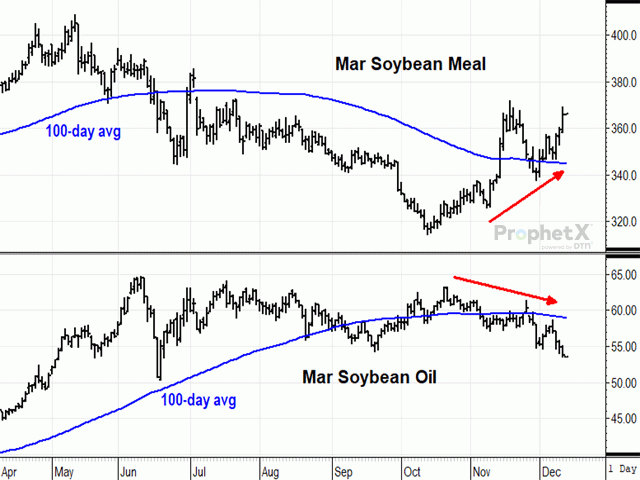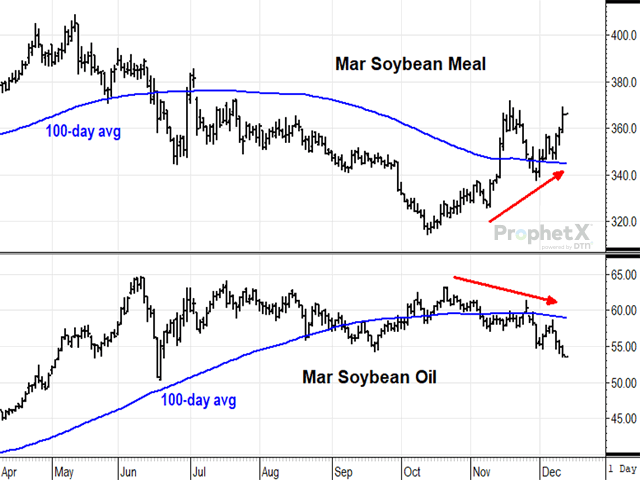Technically Speaking
Changing of the Guard in the Soy Complex
SOYBEAN MEAL:
March soybean meal closed up $10.10 last week, ending at $365.90, the highest close in four months with signs of strong demand from end users. The December soybean meal contract expires Tuesday and has only had seven deliveries reported so far. The December contract was priced $12.00 above the March contract on Friday, a strong sign of demand from end users willing to pay up to secure physical supplies in December. Technically, March soybean meal broke above its 100-day average on Nov. 12, stumbled near the end of the month and then returned back above the average on Dec. 3. Fundamentally, it is difficult to know how much the lysine shortage will boost meal demand, but judging by end-user interest, the uptrend in meal is likely to continue.
SOYBEAN OIL:
March soybean oil fell 3.31 cents last week to 53.76 cents, its lowest close in five months. Last week's lower close confirmed a downward change in trend that lasted well over a year and was supported by lower palm oil production in Malaysia due to the pandemic, lower canola production in 2021 due to drought and a new political environment that is trying to encourage low carbon fuels, renewable biodiesel being one of the more promising innovations. Technically speaking, March soybean oil peaked at 64.68 cents in June, traded within a narrowing sideways triangle for five months and then broke to the downside on Nov. 30. Friday's new five-month low caught 62,445 noncommercials still net long, positions that will be under pressure to liquidate.
SOYBEANS:
In spite of a big gain in meal and substantial drop in soybean oil prices last week, March soybeans were generally calm, ending up 3 cents on the week at $12.73 3/4. Based on January futures prices, the theoretical crush value of the two soy products fell 23 cents to $14.91 Friday, but still represented a generous return over the January soybean price of $12.68. It is the export side of soybean demand that is concerning with U.S. soybean export sales commitments running 27% below last year's record pace. Technically speaking, March soybeans broke out of a sideways triangle to the downside on Aug. 20. After brief turbulence, March prices consistently traded below the 100-day average since Aug. 26 and fell to a low of $11.93 on Nov. 9. Prices have firmed since the November low, but remain in a downtrend, just below the 100-day average at $12.87. The recent firming in prices is puzzling, given export sales concerns.
Comments above are for educational purposes only and are not meant as specific trade recommendations. The buying and selling of grain or grain futures or options involve substantial risk and are not suitable for everyone.
Todd Hultman can be reached at todd.hultman@dtn.com
Follow him on Twitter @ToddHultman1
(c) Copyright 2021 DTN, LLC. All rights reserved.
P[L1] D[0x0] M[300x250] OOP[F] ADUNIT[] T[]






Comments
To comment, please Log In or Join our Community .